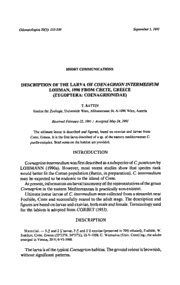
Description of the larva of Coenagrion intermedium Lohman, 1990 from Crete, Greece (Zygoptera: Coenagrionidae) PDF
Preview Description of the larva of Coenagrion intermedium Lohman, 1990 from Crete, Greece (Zygoptera: Coenagrionidae)
Odonatologica20(3):333-336 SeptemberI, 1991 SHORT COMMUNICATIONS Descriptionofthelarva ofCoenagrionintermedium Lohman, 1990from Crete, Greece (Zygoptera: Coenagrionidae) T. Battin InstitutfurZoologie,Universitat Wien,Althanstrasse 14,A-1090 Wien, Austria ReceivedFebruary 22, 1991 /AcceptedMay 24, 1991 The ultimateinstar isdescribed and figured,based onexuviae and larvae from Crete, Greece.Itisthefirst larvadescribed ofasp. oftheeasternmediterranean C. puc/Za-complex.Briefnotesonthehabitat areprovided. INTRODUCTION Coenagrion intermediumwasfirstdescribedasasubspecies ofC.ponticumby LOHMANN (1990a). However, most recent studies show that species rank wouldbetterfit theCretanpopulation (Battin, inpreparation). C. intermedium maybeexpected tobeendemic to theislandofCrete. Atpresent,informationonlarvaltaxonomyoftherepresentativesofthegenus Coenagrion in theeastern Mediterraneanis practically non-existent. UltimateinstarlarvaeofC. intermediumwerecollectedfromastreamletnear Fodhele, Crete and successfully rearedto theadult stage. The description and figuresarebasedonlarvaeandexuviae, bothmaleandfemale.Terminologyused forthelabiumis adopted fromCORBET (1953). DESCRIPTION Material. —5$and 2$iarvae,3S and 2$exuviae(preservedin70%ethanol),Fodhele, W. Iraklion,Crete,Greece (35°22'N,24°57'E), I8-V-1988.C. Woreadou(Univ.Crete)leg,;the adults emergedinVienna,29-V/4-VI-I988. Thelarvaisofthetypical Coenagrionhabitus.Theground colourisbrownish, withoutsignificant patterns. 334 T.Battin Measurements (inmm).— Bodylength(excludingantennaeand caudal lamellae): 12.5;— antennae:2.6;—caudal appendages5.5;—praementum,length:2.7;width 1.9;—prothoracalleg (femur-tibia-tarsi):2.0-2.5-1.4; —metathoracal leg: 2.6-3.0-1.2;— metathoracal leg: 2.9-3.4-1.2. Antennae 7-segmented, pedicellus about twice as long as scapus (Fig. 1). Postocularregionwithsmall-spotcolouringandrudimentary spine shaped setae. Ventralmarginofeye witha row ofspiniform setae. Prementum(Fig. 2)with5 equallysized premental setae. Thedistalmarginof the medianlobe presents very small, blunt spines (Fig. 3). Each labialpalp provided with7palpalsetae,aboutaslongasthemovablehook.Distalmarginof labialpalps(Fig. 4)with5to7bluntteethandastrong,inwardcurvedendhook. Mandibles(Fig.5)armedwith4-5unequallysizedouterteeth,connectedoneach sideto apointed lateraltooth.Innermarginwith astout,solitary tooth.Maxilla (Fig. 6)withgaleasimple andprovided with diminutive,slightly featheredsetae, thelaciniawith5unequally sized,largecurvedandstrongteethaswellaswith5-6 smaller ones. Wing sheaths reaching about the posterior third of abdominalsegment 4. Proximalpart offemoraincompletely and distalparts distinctlybanded with dark brown. Theinsideofthe apical tibiaeis densely provided with tridentate setae,whileunidentate,featheredsetae arepredominant ontheinnersideoftarsi. Femalegonapophysis (Fig. 7)extending totheposteriorborderofsegment10. The apexofthe valvulapresents 2 sharp spiniform setae. Male genitalia as in Figure 8. Caudal lamellaewithout distinct pigmentation (Fig. 9). Nodal line undulated, apices slightly pointed. Median caudal lamella: dorsal margin of antenodalpart with strong spiniform setae, postnodal part densely set with piliformsetae.Ventrally, spiniformandpiliformsetaeshorterandless denselyset than dorsally. Inlateral caudallamellaedorsoventralposition and shaping of setae reversed with respect to themedianone. NOTES ON HABITAT The larvae of C. intermedium were collected in the permanent part of a streamlet, mainly surroundedby cultivatedareas. In Augustthewater tempera- turevariesbetween19.5and20°Cwithanoxygen concentrationofabout78mg/1 and a pH ofabout 7.6. In riffle areas the substrate predominantly consists of stones andgravel. Important amounts ofdetritus deposits are accumulated in pools. The anisopteran faunaofthestreamletis rathervaried,otherassociated Zygoptera were Calopteryxsplendens and Ischnuraelegans ebneri. Figs I-9,Coenagrionintermedium (Lohmann):(I)antenna;— (2)labium,innerviewofprementum; —(3)distal marginofprementum; —(4)rightlabialpalpofprementum;— (5)leftmandible,inner side;— (6)rightmaxilla,inner side; —(7)end offemale abdomen,left lateralview; —(8)male gonapophysis,ventralview;—(9)median(a), andlateral(b)caudallamella. —[ScalebarforFigsI, 2,4,7,8, 9: Imm;—forFigs 3,5,6:0,5mm]. LarvaofCoenagrionintermedium 335 336 T. Battin DISCUSSION This is thefirst larva described fromthe eastern MediterraneanCoenagrion puella-complex sensuLOHMAN(1990b),originallyincludingC.syriacum, C.p. ponticum, C.p. intermediumand C. puella. Striking affinities can benoticed betweenthelarvaofC. intermediumandthe descriptionbyCARCHINI (1983) ofC.puellafromItaly,which, bytheway,cannot beclearly differentiatedfrom Italian C.pulchellum. However, becauseof the rather high intraspecific varia- bilityofsomediagnosticfeaturesincoenagrionid larvae(e.g. GARDNER, 1977), itwouldbeprematureto draw anyconclusionsfromthesescantydataasto the taxonomicaffinitieswithinthespecies complex atthis stage. ACKNOWLEDGEMENTS 1would liketothank CATHERINA WOREADOU(University ofCrete)forcollectingthelarval material and JOHANN WAR1NGER (University ofVienna)forreading anearlier draft ofthis paper. REFERENCES CARCH1N1,G.,1983.AkeytotheItalianodonatelarvae. Soc.int.odonatol.rapidComm.(Suppl.) I: 1-101. CORBET,P.S., 1953.Aterminologyforthelabium oflarval Odonata, Entomologist86: 191-196. GARDNER, A.E., 1985. A key tolarvae. — ln: P.S. Corbet, C. Longfield& N.W. Moore, Dragonflies,pp. 191-223,Collins, London. LOHMANN, H., 1990a. Coenagrionponticum intermedium subspec. nov. vonder Insel Kreta, Griechenland (Odonata:Coenagrionidae).Opusc.zool.ßumin.54: 1-7. LOHMANN, H., 1990b. Revision der Coenagrion puella-Artengruppe (Zygoptera: Coena- grionidae).Unpublishedmanuscript.
